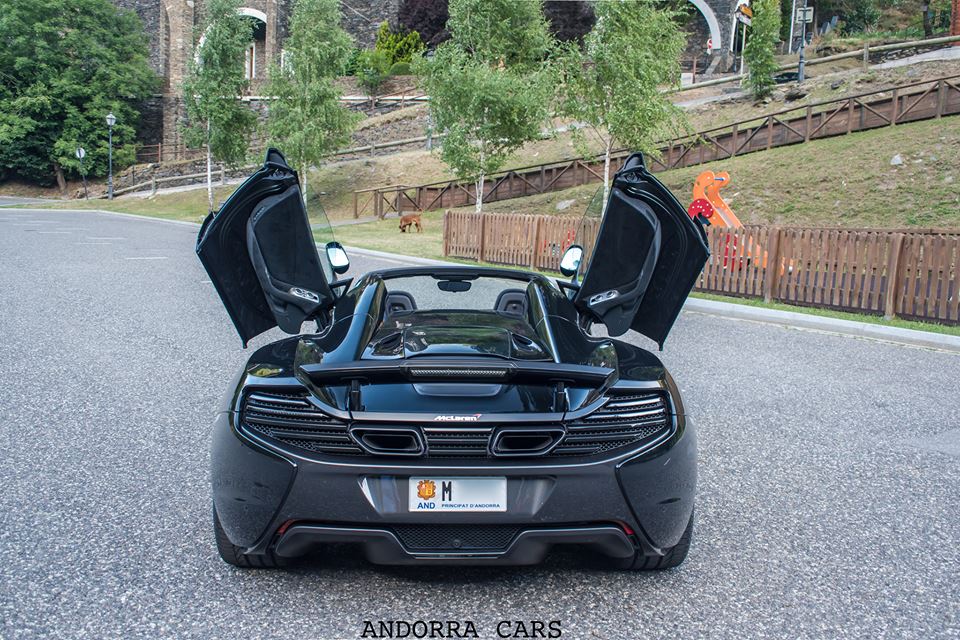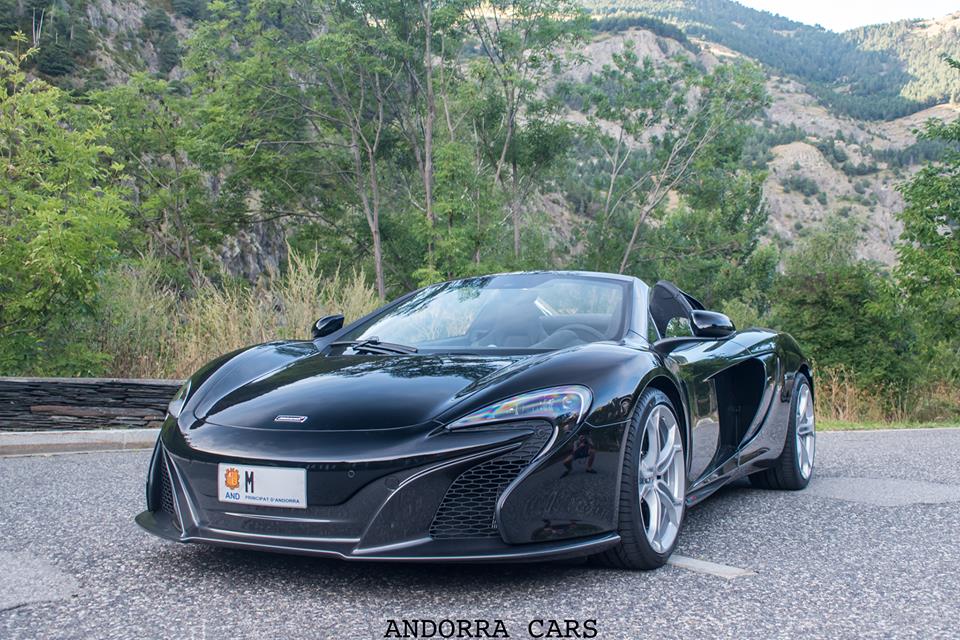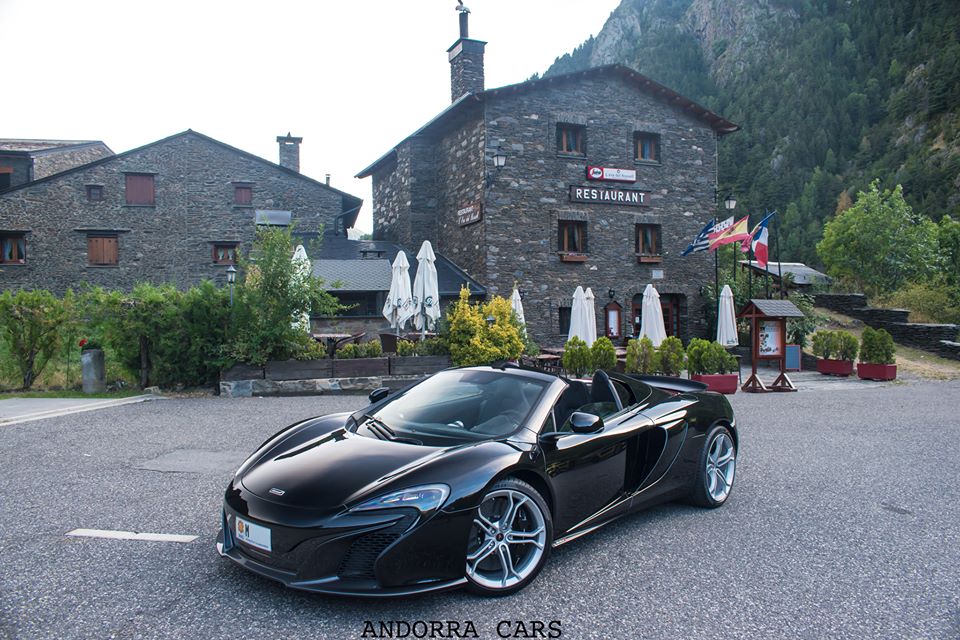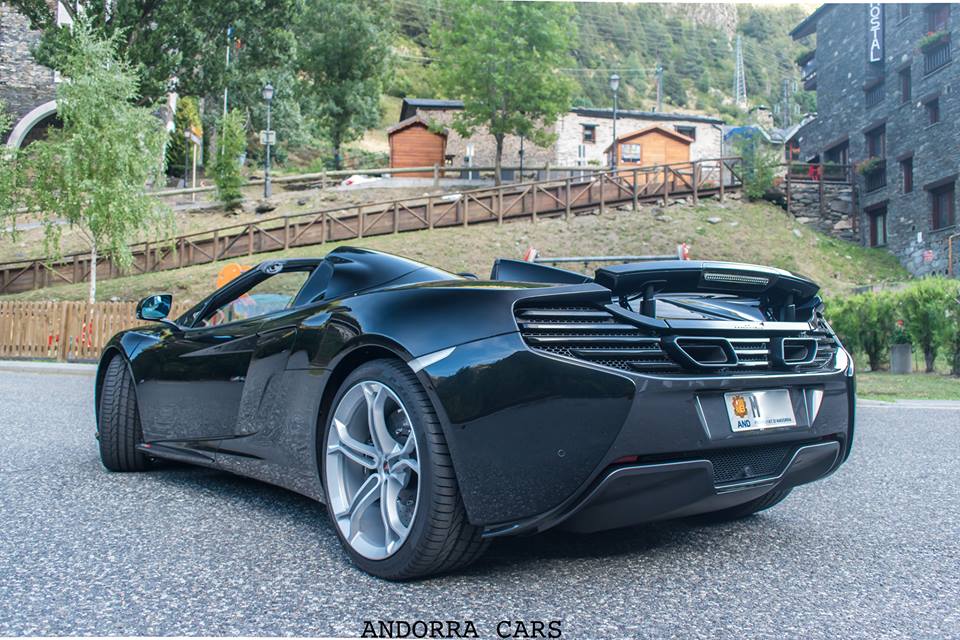Black McLaren 650S. Photos from Andorra
The McLaren 650S is a British sports car designed and manufactured by British automobile manufacturer McLaren Automotive. It was announced in February 2014 as a new model, but based on the existing MP4-12C with 25% new parts, and was formally unveiled at the 2014 Geneva Motor Show.
The 650S shares the MP4-12C’s carbon-fibre-reinforced polymer chassis, and is powered by the same 3.8-litre twin-turbocharged McLaren M838T V8 engine, but is now rated at 650 PS (478 kW; 641 hp) and 500 lb⋅ft (678 N⋅m) of torque. Power is transmitted to the wheels through a seven-speed dual-clutch Seamless-Shift gearbox (SSG) provided by Graziano Trasmissioni.
The 650S is an evolution of the preceding 12C and uses the findings gained from the P1 in order to make the car more responsive and focused. It was initially designed to be offered alongside the 12C but the declining sales of the 12C prompted McLaren to market the 650S as its replacement.
The 650 in the car’s name refers to the engine’s power output in Pferdestärke, the European standard for horsepower while the S stands for Sport.
Most of the components are carried over from the 12C which includes the carbon-fibre monocoque chassis which has aluminium subframes front and aft. The monocoque weighs 75 kg (165 lb) and is manufactured by Carbo Tech, an aerospace contractor based in Austria. With an aim of building 4,000 cars per year, McLaren deemed the traditional pre-impregnation method used to mould parts too labour-intensive and instead used an alternative method which involves a resin transfer moulding process.
The process involves a mould whose tooling involves internal, removable mandrels for the hollow sections which allows the tub to be built in one piece. The pre-cut sheets of carbon fibre are placed in the tooling of the mould and aluminium components are also positioned to be bolted onto the monocoque later. To avoid the galvanic corrosion between aluminium and carbon, the aluminium components of the chassis are primed before assembly. The wide and deep hollow box sections on each side of the carbon fibre tub are designed for easy entry and exit from the car.
The powertrain of the 650S is largely carried over from the 12C but involves new pistons, better-flowing cylinder heads, new exhaust valves, and recalibrated camshaft timing. A new exhaust system also reduces weight while being more responsive. The red-line of the engine was increased to 8,500 rpm.
The engine is mated to the same 7-speed dual clutch transmission as in the 12C but it has been recalibrated for faster shift times. The 650S comes with new aluminium forged wheels wrapped in Pirelli P Zero Corsa tyres having wider contact patch than the previous versions for improved grip.
In order to improve ride quality, McLaren used ProActive Chassis Control (PCC) which is a derivative of McLaren’s F1 active suspension system. The system consists of dampers on either sides of the car which are hydraulically linked which allows the car to resist roll. The dampers have been divided into sections for rebound and compression. The front damper’s compression is linked to the rear damper’s rebound. The pressure is gathered in an accumulator which is controlled using gas pressure, by adjusting the pressure in each accumulator, the stiffness of the suspension is adjusted for different driving conditions.
A new front splitter and redesigned wing blades increase downforce by 24% over the 12C while the new tyres contribute to improved handling. The new rear diffuser is based on the bumper/diffuser concept and is carried over from the 12C GT3 race car. The air brake which is carried over from the 12C is now controlled by an onboard computer which uses the data gathered from accelerometers in the car in order to counteract lift. The 650S also makes use of a Drag Reduction System (DRS) for reducing drag and to improve the car’s aerodynamics. Like the 12C, the 650S comes standard with a carbon ceramic braking system manufactured by Akebono but the problems related to braking response in the 12C were addressed and improvements were made.
The 650S featured a revised front end, resembling the flagship P1 in order to update the styling of the car and to give it a more aggressive appearance than its predecessor. The design language defined the design ethos of future McLaren sports cars.
The interior includes Alcantara as the standard upholstery material and the infotainment system is based on the same unit used in the P1. Optional carbon fibre sports seats reduce the weight of the car by 15 kg. The interior focus on a symmetrical design language which McLaren claims reduces the shift time required by the owner to learn about the car’s functions. The portrait infotainment screen is improved over the 12C and the sat nav system is now easily accessible.
The 650S has a claimed top speed of 333 km/h (207 mph), and can accelerate from 0–100 km/h (0–62 mph) in 3.0 seconds and from 0–200 km/h (0–124 mph) in 8.4 seconds.





















